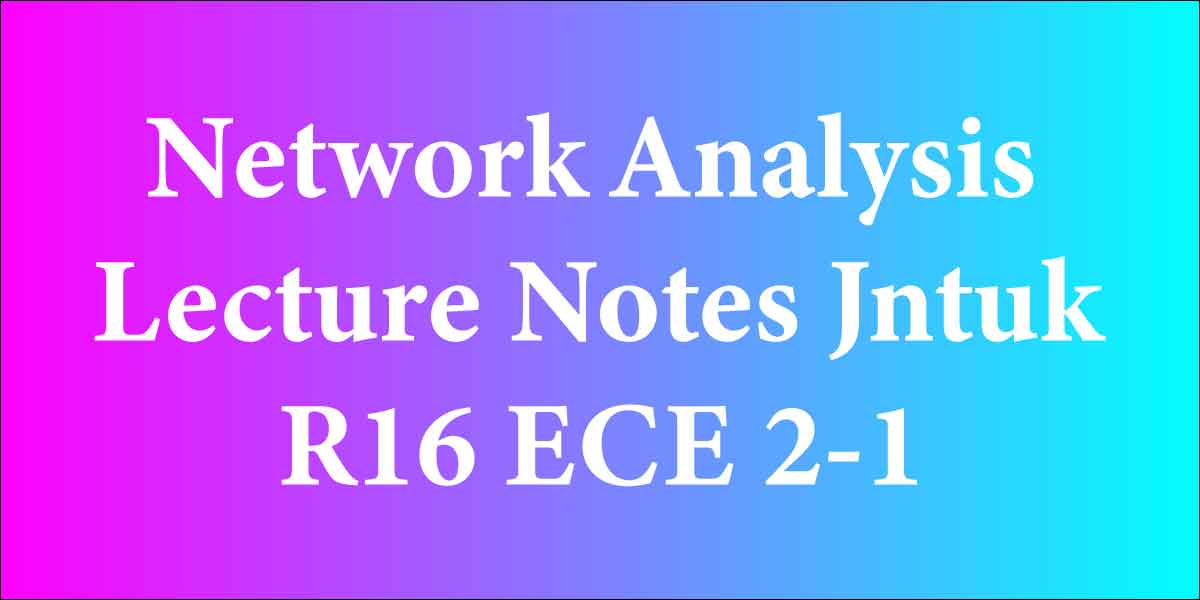Network Analysis
UNIT – I
Introduction to Electrical Circuits : Network parts classification, charge and current, electrical energy and potential, Resistance parameter – series and parallel combination, Inductance parameter – series and parallel combination, Capacitance parameter – series and parallel combination. Energy sources: Ideal, Non-ideal, freelance and dependent sources, supply transformation, Kirchoff’s laws, Mesh analysis and Nodal analysis downside determination with resistances solely as well as dependent sources conjointly. (Text Books: one,2,3, Reference Books: 3) A.C Fundamentals and Network Topology: Definitions of terms related to periodic functions: period of time, Angular rate and frequency, RMS value, Average price, type issue and peak factor- downside determination, point in time, Phasor illustration, Addition and subtraction of phasors, mathematical illustration of curving quantities, clarification with relevant theory, downside determination. Principal of Duality with examples. Network Topology: Definitions of branch, node, tree, planar, non-planar graph, incidence matrix, basic tie set schedule, basic cut set schedule. (Text Books: two,3, Reference Books: 3)
UNIT – II
Steady State Analysis of A.C Circuits : Response to curving excitation – pure resistance, pure inductance, pure capacitance, electric resistance construct, point in time, series R-L, R-C, R-L-C circuits downside determination. advanced electric resistance and phasor notation for R-L, R-C, R-L-C downside determination victimization mesh and nodal analysis, Star-Delta conversion, downside determination. (Text Books: one,2, Reference Books: 3)
UNIT – III
Coupled Circuits : Coupled Circuits: Self inductance, coefficient, constant of coupling, analysis of coupled circuits, Natural current, Dot rule of coupled circuits, Conductively coupled equivalent circuits- downside determination. Resonance: Introduction, Definition of letter, Series resonance, information measure of series resonance, Parallel resonance, Condition for max electric resistance, current in opposed resonance, information measure of parallel resonance, general case- resistance gift in each branches, opposed resonance in any respect frequencies. (Text Books:2,3, Reference Books: 3)
UNIT – IV
Network Theorems: Thevinin’s, Norton’s, Milliman’s, Reciprocity, Compensation, Substitution, Superposition, goop Power Transfer, Tellegens- downside determination victimization dependent sources conjointly. (Text Books: one,2,3, Reference Books: 2)
UNIT – V
Two-port networks : Relationship of 2 port networks, Z-parameters, Y-parameters, cable parameters, h-parameters, Inverse h-parameters, Inverse cable parameters, Relationship between parameter sets, Parallel association of 2 port networks, Cascading of 2 port networks, series association of 2 port networks, downside determination as well as dependent sources conjointly. (Text Books: one,2, Reference Books: one,3)
II Year – I Semester
L T P C
4 0 0 3
NETWORK ANALYSIS
UNIT – VI
Transients : 1st order differential equations, Definition of your time constants, R-L circuit, R-C circuit with DC excitation, Evaluating initial conditions procedure, second order differential equations, unvaried, nonhomogenous, downside determination victimization R-L-C parts with DC excitation and AC excitation, Response as associated with s-plane rotation of roots. Solutions victimization Marquis de Laplace remodel methodology. (Text Books: one,2,3, Reference Books: one,3)
TEXT BOOKS:
one. Network Analysis – ME Van Valkenburg, beginner Hall of Asian country, third Edition, 2000. 2. Network Analysis by K.Satya Prasad and S Sivanagaraju, Cengage Learning three. circuit Analysis by Hayt and Kimmarle, TMH
REFERENCES:
one. Network lines and Fields by John. D. Ryder ordinal edition, Asia firm. 2. Basic Circuit Analysis by DR Cunninghan, Jaico Publishers. 3. Network Analysis and Filter style by Chadha, Umesh Publications.
COURSE OBJECTIVES:
- to grasp the essential ideas on RLC circuits. 2. to grasp the behavior of the steady states and transients states in RLC circuits. 3. to grasp the essential Marquis de Laplace transforms techniques in periods’ waveforms. 4. to grasp the 2 port network parameters. 5. to grasp the properties of LC networks and filters.
COUSE OUTCOME: - gain the data on basic network parts. 2. can analyze the RLC circuits behavior in elaborate. 3. analyze the performance of periodic waveforms. 4. gain the data in characteristics of 2 port network parameters (Z, Y, ABCD, h & g). 5. analyze the filter style ideas in globe applications.
[content-egg module=Amazon template=list]

